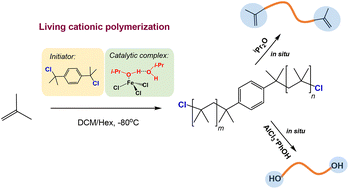Quasiliving carbocationic polymerization of isobutylene using FeCl3 as an efficient and water-tolerant Lewis acid: synthesis of well-defined telechelic polyisobutylenes†
Abstract
Quasiliving cationic polymerization of isobutylene with dicumyl chloride (DiCumCl)/FeCl3/iPrOH in CH2Cl2/n-hexane 40/60 v/v at −80 °C has been investigated. It was shown that this initiating system afforded well-defined difunctional low molecular weight polyisobutylenes (Mn from 1250 g mol−1 to 21 000 g mol−1, Đ ≤ 1.28) possessing predominantly chlorine end groups (>90%) with a small fraction of exo-olefin end groups. A one-step approach to convert this difunctional polymer to an exclusively exo-olefin-terminated polyisobutylene by end quenching the quasiliving polyisobutylene with iPr2O was developed. In addition, the synthesized polymers were successfully converted into phenol-terminated difunctional polyisobutylenes via one-step alkylation of phenol by quasiliving polyisobutylene chains at room temperature. Remarkable, FeCl3-based initiating systems required a much lower concentration of Lewis acid and displayed much higher water tolerance as compared to widely used TiCl4-based initiating systems. The mechanistic studies revealed that complexes of FeCl3 with alcohols (iPrOH, BuOH) or ethers (iPr2O, Bu2O), not a free Lewis acid, participate in the initiation and propagation steps of the polymerization. The polymerization needs to be conducted at a low polymerization temperature (−80 °C) to suppress the formation of a free base, which induced undesirable β-H abstraction leading to the formation of olefinic end groups and admixtures of monofunctional PIB chains.



 Please wait while we load your content...
Please wait while we load your content...